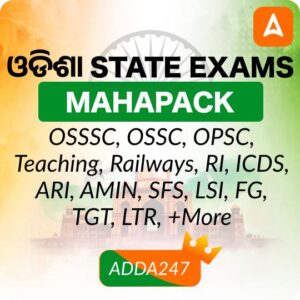Mathematics is an integral part of various competitive exams, including the OSSSC (Odisha Subordinate Staff Selection Commission) RI (Revenue Inspector), ARI (Assistant Revenue Inspector), Amin, SFS, and ICDS Supervisor exams. To excel in these exams, candidates need to have a solid understanding of mathematical concepts and problem-solving skills. To help you prepare effectively, we’ve compiled a list of the top 30 Mathematics Multiple Choice Questions (MCQs) commonly encountered in these exams.
Top 30 Mathematics MCQS For OSSSC RI,ARI, Amin, SFS, ICDS Supervisor
- If x is a positive integer such that {3x + 5}/{7} is an integer, what is the smallest possible value of x?
- (a) 1
- (b) 2
- (c) 3
- (d) 4
Ans: (d) 4
Solution: Let frac{3x + 5}/{7} = k, where k is an integer. Thus, . Rearranging, 3x=7k−5. For x to be an integer, 7k−5 must be divisible by 3. Trying successive values of k, the smallest that satisfies this condition is k=3. Substituting, 3x=21−5, so x=16/3. Trying the next k=4, , so x=23. Finally, trying k=5,, so x=10. Hence, the smallest is 10.
- A man spends 40% of his monthly salary on rent, 25% on food, and 15% on transportation. If he saves ₹9,000, what is his total monthly salary?
- (a) ₹30,000
- (b) ₹36,000
- (c) ₹40,000
- (d) ₹45,000
Ans: (b) ₹36,000
Solution: Let the monthly salary be S. He spends 40%+25%+15%=80% of his salary, so he saves 100%−80%=20%. If 20%of the salary is ₹9,000, then 100% of the salary is (9,000×100)/20=₹45,000
- The average of 5 numbers is 15. If two of the numbers are 10 and 20, what is the average of the remaining 3 numbers?
- (a) 10
- (b) 12
- (c) 15
- (d) 20
Ans: (a) 10
Solution: Solution: The sum of the 5 numbers is 5×15=75. The sum of the first two numbers is 10+20=30. Thus, the sum of the remaining 3 numbers is 75−30=45. Therefore, the average of the remaining 3 numbers is 45/3 =15..
- A sum of money doubles in 5 years at simple interest. What is the rate of interest per annum?
- (a) 10%
- (b) 20%
- (c) 15%
- (d) 25%
Ans: (b) 20%
Solution: Solution: Let the principal be 𝑃 and the rate of interest be r%. In 5 years, the amount is 2P, and the simple interest is P. Simple interest formula is SI=(P×r×t)/100
Thus, P= (P×r×t)/100 , so 𝑟=100/5=20%. - A train travels from point A to point B in 3 hours at a speed of 60 km/hr. If it travels from B to A at a speed of 90 km/hr, what is the average speed of the train for the entire journey?
- (a) 72 km/hr
- (b) 75 km/hr
- (c) 80 km/hr
- (d) 85 km/hr
Ans: (a) 72 km/hr
Solution: The distance between A and B is 60×3=180 km. Time taken from B to A is 180/90=2 hours. Total distance for the round trip is 180+180=360 km, and total time is 3+2=5 hours. Average speed is 360/5=72 km/hr..
- The sum of the squares of two consecutive odd numbers is 410. What are the numbers?
- (a) 9 and 11
- (b) 11 and 13
- (c) 13 and 15
- (d) 15 and 17
Ans: (b) 11 and 13
Solution: Let the odd numbers be x and x+2. Then, x^2 + (x+2)^2 = . Expanding and solving: x^2 + x^2 + 4x + 4 = , x^2 + 4x + 4 = 410, 2x^2 + 4x = 406, x^2 + 2x = 203=0. Solving x^2 + 2x – 203 ,, x=11. Therefore, the numbers are 11 and 13.
- If a car covers 180 km in 3 hours and another car covers 240 km in 4 hours, what is the ratio of their speeds?
- (a) 3:4
- (b) 4:3
- (c) 2:3
- (d) 3:2
Ans: (b) 4:3
Solution: Speed of the first car is 180/3 =60 km/hr. Speed of the second car is 240/4 =60 km/hr. The ratio of the speeds is 60/60=1:1.
- A man buys a watch at a discount of 25% on the marked price. If he sells it for ₹9000, what was the marked price?
- (a) ₹10,000
- (b) ₹12,000
- (c) ₹13,500
- (d) ₹15,000
Ans: (a) ₹12,000
Solution: Let the marked price be 𝑀. After a 25% discount, the selling price is 75% of 𝑀 =0.75M=9000, hence M= 9000/0.75 =12000.
- The sum of three consecutive integers is 69. What are the integers?
- (a) 22, 23, 24
- (b) 21, 22, 23
- (c) 23, 24, 25
- (d) 20, 21, 22
Ans: (b) 21, 22, 23
Solution: Let the integers be x−1, x, and x+1. Then,
(x−1)+x+(x+1)=69, 3x=69, x=23. Hence, the integers are 22, 23, and 24. - A student scores 85, 90, and 80 in three subjects. If the average score needs to be 88 for the fourth subject, what must be the score in the fourth subject?
- (a) 95
- (b) 96
- (c) 97
- (d) 98
Ans: (a) 95
Solution: Let the score in the fourth subject be x.
The average score is 85+90+80+x =88.
Solving for 255+x=352,
x=352−255=97. - A man buys 4 pens for ₹40 and sells them at a price of ₹12 each. What is his profit percentage?
- (a) 20%
- (b) 25%
- (c) 30%
- (d) 35%
Ans: (b) 25%
Solution: Cost price of 4 pens = ₹40,
hence cost price of 1 pen = ₹10. Selling price of 1 pen = ₹12. Profit per pen = ₹12 – ₹10 = ₹2.
Total profit = ₹2 times 4 = ₹8.
Total cost price = ₹40.
Profit percentage = 8/40×100=20% - A shopkeeper increases the price of an item by 25% and then gives a 10% discount. What is the effective percentage increase in the price of the item?
- (a) 10%
- (b) 15%
- (c) 12.5%
- (d) 20%
Ans: (c) 12.5%
Solution: Let the original price be ₹100. After a 25% increase, the new price is ₹125. After a 10% discount on ₹125, the selling price is 125×(1−0.10)=125×0.90=112.5. The effective increase is 112.5−100= 12.5.
Percentage increase =12.5/100×100=12.5%. - A student scores 70, 75, 80, and 85 in four tests. If the scores are to be in arithmetic progression, what is the score of the fifth test if the average score of all five tests is 80?
- (a) 90
- (b) 85
- (c) 95
- (d) 100
Ans: (a) 90
Solution: The sum of the five scores = 80×5=400.
The sum of the first four scores = 70+75+80+85=310.
Hence, the score of the fifth test =
400−310=90. - A man borrows ₹10,000 at 8% per annum compound interest. What is the amount he will have to pay after 2 years?
- (a) ₹11,664
- (b) ₹11,600
- (c) ₹11,680
- (d) ₹11,760
Ans: (a) ₹11,664
Solution: Amount
𝐴=𝑃(1+𝑟/100)^𝑡
Here,
P=10,000,
r=8%, and
t=2. Thus,
A=10,000(1+8/100)^8
=10,000(1.08)^2
=10,000×1.1664=11,664. - A person buys an article for ₹720 and sells it at a profit of 20%. What is the selling price?
- (a) ₹864
- (b) ₹840
- (c) ₹900
- (d) ₹880
Ans: (a) ₹864
Solution: Selling price = 720×(1+0.20)=720×1.20=₹864.
- The sum of the squares of two numbers is 289, and their difference is 7. What is the product of the numbers?
- (a) 84
- (b) 90
- (c) 96
- (d) 105
Ans: (a) 84
Solution: Let the numbers be x and y. Given
x ^2 +y ^2 =289 and
x−y=7. We use the identity
(x−y) ^2 =x ^2 +y ^2 −2xy.
Hence,
49=289−2xy, so
2xy=240,
xy=120.. - The ratio of the ages of two brothers is 3:4. Five years ago, the sum of their ages was 46. What are their current ages?
- (a) 20 and 25
- (b) 21 and 28
- (c) 24 and 32
- (d) 27 and 36
Ans: (c) 24 and 32
Solution: Let the ages be 3x and 4x. Five years ago, their ages were
3x−5 and 4x−5. Thus,
(3x−5)+(4x−5)=46,
solving gives
7x−10=46, hence x=8.
Therefore, their current ages are
3×8=24 and 4×8=32. - A sum of money triples itself in 10 years at simple interest. In how many years will it become nine times itself?
- (a) 20 years
- (b) 30 years
- (c) 40 years
- (d) 50 years
Ans: (c) 40 years
Solution: If the money triples in 10 years, it means the interest for 10 years is equal to twice the principal. To become nine times, the money must increase by 8 times the principal. Since the interest is proportional to time, 8/2=4*10 = years.
- If the sum of the ages of a father and his son is 45 years and the father is 5 times as old as the son 10 years ago, what are their current ages?
- (a) 35 and 10
- (b) 40 and 5
- (c) 30 and 15
- (d) 40 and 15
Ans: (a) 35 and 10
Solution: Solution: Let the son’s age be
x and the father’s age be 45−x.
Ten years ago, the father’s age was
45−x−10=35−x, and the son’s age was x−10. Given 35−x=5(x−10), solving gives 35−x=5x−50,
6x=85, so x=10.
Hence, the father’s age is
45−10=35.. - A number is decreased by 20% and then increased by 25%. The resulting number is 90. What was the original number?
- (a) 100
- (b) 96
- (c) 80
- (d) 75
Ans: (a) 100
Solution: Let the original number be xx. After a 20% decrease, the number is 0.8x. After a 25% increase, the number becomes . Hence, x=90.
- The ratio of the speeds of two cars is 4:5. If the first car covers 120 km in 2 hours, how long will it take for the second car to cover 150 km?
- (a) 2 hours
- (b) 2.5 hours
- (c) 3 hours
- (d) 4 hours
Ans: (a) 2 hours
Solution: Speed of the first car =
120/2=60 km/hr.
Speed of the second car =
5/4×60=75 km/hr.
Time for the second car to cover 150 km is 150/75=2 hours - What is the sum of the first 50 positive integers?
(a) 1250
(b) 1275
(c) 1225
(d) 1276
Ans: (b) 1275
Solution: The sum of the first n positive integers is given by
n(n+1)/2 =
n=50×51/2=1275 - A father is three times as old as his son. After 15 years, he will be twice as old as his son. What is the father’s current age?
(a) 45
(b) 42
(c) 48
(d) 50
Ans: (a) 45
Solution:
Let the son’s age be 𝑥
x and the father’s age be 3x.
3x+15=2(x+15)
3x+15=2x+30
x=15
Father’s age:
3x=3×15=45 - A and B invest $2000 and $3000 in a business, respectively. If the profit is $2500, what is A’s share of the profit?
(a) $1000
(b) $1200
(c) $1500
(d) $1400
Ans: (a) $1000
Solution:
Total investment = $2000 + $3000 = $5000
A’s share = 2000/5000×2500=2/5×2500=1000 - If 5 men can complete a work in 20 days, how many days will it take for 10 men to complete the same work?
(a) 10
(b) 5
(c) 15
(d) 20
Ans: (a) 10
Solution:
Work done is inversely proportional to the number of men.
5 men×20 days=10 men×x days
5*20/10=10 days - If A can do a piece of work in 12 days and B can do it in 18 days, how long will they take to do it together?
(a) 6 days
(b) 7.2 days
(c) 7.5 days
(d) 8 days
Ans: (b) 7.2 days
Solution:
Work done by A in 1 day = 1/12
Work done by B in 1 day = 1/18
Total work done in 1 day together =
1/12+1/18=(3+2)/36=5/36
Time taken=36/5=7.2 days - A pipe can fill a tank in 10 hours, and another pipe can empty it in 15 hours. If both pipes are opened together, how long will it take to fill the tank?
(a) 30 hours
(b) 25 hours
(c) 20 hours
(d) 15 hours
Ans: (c) 30 hours
Solution:
Rate of filling = 1/10
Rate of emptying = 1/15
Net rate = 1/10−1/15=(3−2)/30= 1/30
Time taken=30 hours - The difference between the place value and the face value of 6 in the numeral 856973 is
(a) 973
(b) 6973
(c) 5994
(d) None of these
Ans: (c) 5994
Sol:place value of 6-Face value of 6=6000-6=5994
The difference between the local value and the face value of 7 in the cameral 32675149
(a) 75142
(b) 64851
(c) 5149
(d) 69993
Ans: (d) 69993
Sol:place value of 7-Face value of 7=70000-7=69993 - What is the volume of a cube with side length 4 cm?
(a) 64 cm³
(b) 48 cm³
(c) 60 cm³
(d) 72 cm³
Ans: (a) 64 cm³
Solution:
Volume=side^3=4^3=64 cm - 150.011 – 419.999 + 649.991 = ?
(a) 350
(b) 365
(c) 375
(d) 380
Ans:(d)










